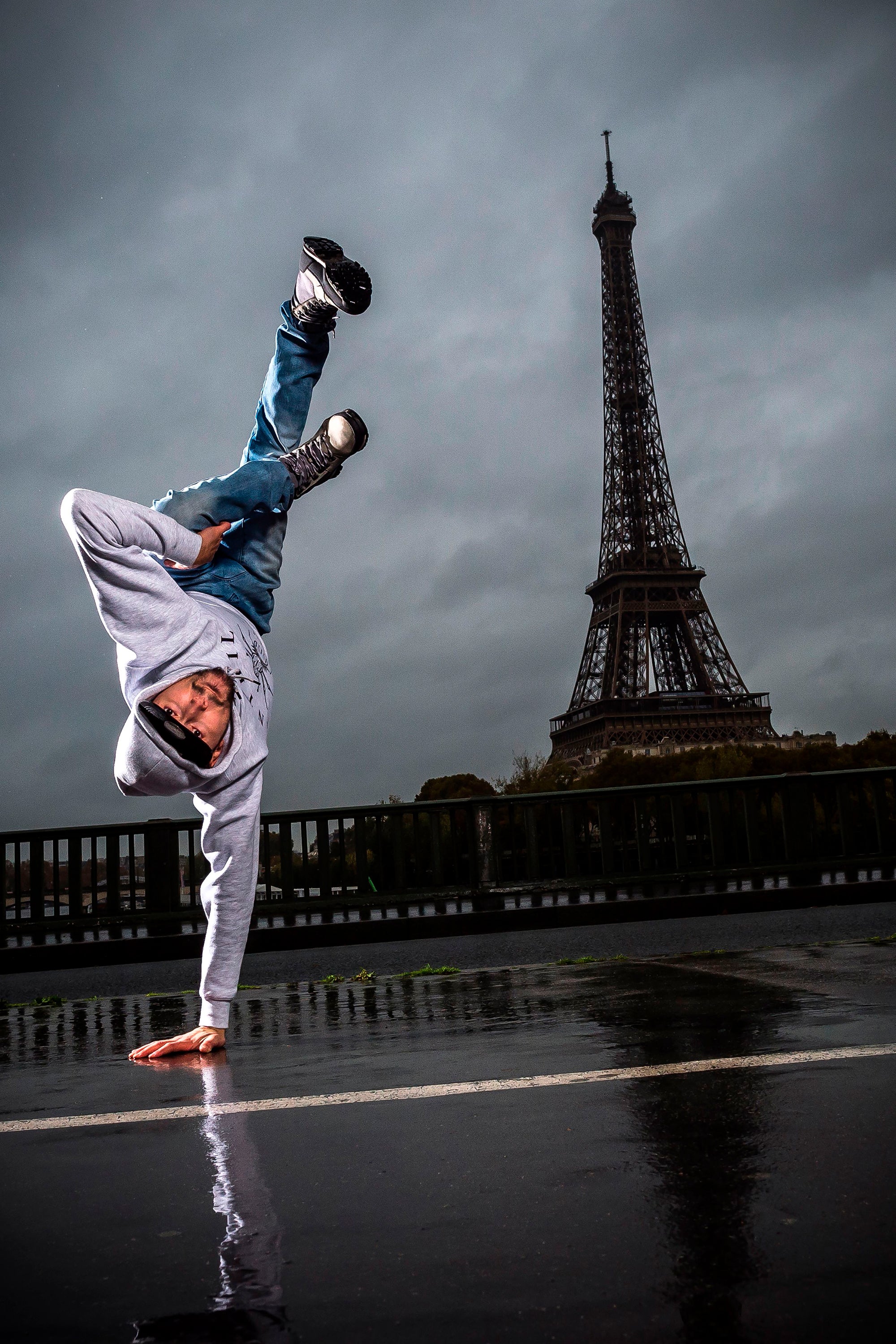For those who know, breaking (or, in the more mainstream parlance, breakdancing) is an art form that has remained a pillar of Hip-Hop culture for more than 45 years. But to others, the dance style is a novelty, a fad from the ’80s occasionally referenced today at parties or in ironic viral videos. That latter could use a culture and history lesson, because whether it’s Vegas act Jabbawockeez, a popular underwear ad, or a bizarre viral fight video peppered with dance, breaking is still everywhere.
When Hip-Hop was born in Bronx parks, breaking was the element that brought all of the others (MCing, DJing, graffiti) together. As block party DJs like Kool Herc and Grandmaster Flash found innovative ways to extend the break of popular funk and disco records, the b-boys and b-girls would hit the floor, showing off elaborate, acrobatic dance moves that eventually led to competitions between the dancers. The DJ ran the show with breakers as the top draw and graffiti artists providing the backdrop. The MCs eventually rose to fame as party-starters, and the rest is Hip-Hop history.
Of course, breaking would go mainstream as it became a pop culture craze in the 1980s. As Hip-Hop went mainstream, movies like the ubiquitous Breakin’ and its notorious sequel Breakin’ 2: Electric Bugaloo put the phenomenon squarely in the middle of the road. But even as those days passed, breaking has maintained a devout underground culture, a worldwide cadre of artists who are committed to keeping this pillar of Hip-Hop culture from fading into the ether.

Breakdancer perform at “The Red Bull Vert Session Tour 2004 / Photo by Dave Etheridge-Barnes/Getty Images
One of the world’s most renowned b-boy and b-girl competitions, Red Bull BC One was launched in Biel, Switzerland, in 2004. Featuring competitors from all over the world doing battle in categories like Breaking & Popping, House Dancing, and All Styles, the event also included workshops and panels with legendary breakers like Jeskilz and Roxrite. Every year, Red Bull invites dancers to face-off in cities across the country, with the final competition held at Red Bull BC One Camp, where they compete for the chance to highlight the Red Bull BC One World Final.
“We come from a different generation,” RoxRite explained to Vibe in 2018. “I come from California, so I have a different understanding of the style that came at a certain time. My job is to go around the world and share that and what it represents, and hopefully it inspires new kids to try this and evolve with this and pursue higher things with breaking. Our job is go on and educate. Without us sharing what this dance is about it’ll fade, because then there’s no understanding of what is, what was, and the foundation of the dance and its history.”
Breaking’s street appeal has always been separate from more disciplined forms of dance, but its edginess is what gives it a singular energy and informs the art itself.
“Dudes flipping and spinning, it’s not like ballet,” he says. “It is literally a gangsta dance, a dance from the poor places.”


FLASHDANCE Japan Movie Poster
Japan’s youth fell in love with breaking after the release of the Hip-Hop cult classic Wild Style in 1983, and once the mid-’80s rapsploitation flicks were in full swing they had become fully immersed in the culture. The depiction of breakers in 1983’s Flashdance also fueled the craze.
“For me, it’s a culture, a lifestyle, it’s all I do,” explained Issei Hori last year. In 2016, Hori was Japan’s first winner of the Red Bull BC One World Finals. “When I was small it blew me away seeing people spinning on their heads. I wanted to be just like them.” Known as The Japanese Ninja, he became a star in Japan after his rise during the 2016 Red Bull competitions.
“The b-Boys in Japan know that they’re true to the origins of Hip-Hop,” said DJ Mar Ski during the 2017 BC One championship. “They care about the four elements and the relationship between MCs, DJs, and breakers. They’re humble, tough, and their quality keeps improving.”
In Israel, the rebelliousness of breaking has become a go-to for Russian, Ukrainian, and Ethiopian immigrants. Crews regularly meet to practice and compete. Channeling their experiences as immigrants in Israel into dance makes for a powerful, cathartic experience. They support themselves by working day jobs or performing at events like bar mitzvahs, and they sustain a thriving underground scene.
“I’ve been on the scene since 2002, and there were a lot fewer people then,” said Dima Peisahov back in 2014. Peisahov, who immigrated to Israel from Russia at age 11 and eventually became the manager of Urban Project, a company that offers breakdancing classes and founded Floor Masterz, an international breakdancing competition. “When we had the first Floor Masterz in 2010, there were 350 people. Last year, about 1,000 people came, half to participate and half to watch.”
The competition now pulls in participants from all over the world, including Japan and the United States.
Breakdancing is definitely trending. The International Olympic Committee has strived to connect with shifting demographics and young audiences throughout its contemporary history. To that end, organizers of the 2024 Summer Games in Paris were able to provisionally add breaking as an official Olympic competition, largely due its popularity in Paris. Breaking was, however, an official event at the 2018 Youth Olympic Games in Buenos Aires.

B-boy in front of the Eiffel Tower / Photo by LIONEL BONAVENTURE/AFP via Getty Images
While some may side-eye the idea of Olympic breaking, it makes sense considering the time and the art form’s lengthy history.
The legends of the game are watching while continuing to beat the drum for the art form as ambassadors of the culture. Rock Steady Crew founding member Richard “Crazy Legs” Colón is one of the most recognized b-boys in the world, and he was there from the beginning, when Hip-Hop was just emerging from the Bronx.
Crazy Legs became a household name after appearing in a string of classic early Hip-Hop films. Movies like Beat Street, Style Wars, and Wild Style helped capture the art form in the early ’80s. Crazy Legs has spent the last three-plus decades preaching the gospel of breaking. He’s arguably the culture’s most revered ambassador, and his love for the art informs much of what he does. He’s launched his live-streaming cooking show “Lunch Breaks” and helped bring Bouncing Cats, a documentary about Breakdance Project Uganda, to the big screen in 2019.
It was back in 1977 on Katonah Avenue in the Bronx, when Crazy Legs realized he wanted to be a b-boy. “For me, when I first started getting into the scene, I was trying everything!” Crazy Legs told Red Bull Academy in 2018. “I tried to DJ because my three older brothers were DJs. When they’d leave the house I’d sneak on the turntables, until one day they rewired them and I didn’t know what I was doing! Ha-ha! I wrote graffiti, I wrote rhymes, and then, when I went to my first jam, I started becoming a b-boy.”

Crazy Legs 1983 / Photo by Linda Vartoogian/Getty Images
The Puerto Rican then-teen couldn’t have imagined how far breaking would take him in life. Now helping to spearhead the Red Bull competition, Legs is an icon and breaking is a widespread cultural touchstone.
“It’s more of a level playing field now when it comes to the diversity of the dancers,’ Crazy Legs told Red Bull Academy. “There’s a strong focus to have your foundation and allow yourself to be taken away with the music, so that your style can kick in, flex your confidence, and still have those blow-up moves, your freezes. There’s a better balance than there ever has been.”
The mainstream is finally starting to recognize breaking as more than a novelty.
“I'll go through immigration, and they ask me what I do, and I say breaking, and they'll go, ‘They still do that s**t?’ ” RoxRite told Vibe in 2018. “For me, it was put under this category of ’80s dances, and it’s hard to go over that hump,”
Breaking is an aspect of the culture that is now consistently overshadowed by the rap music industry. But the b-boy and b-girl are the arbiters of much of what is considered as Hip-Hop. Today, from the Bronx to Bel Air, from Japan to Israel, the steelo is thriving. The world is finally catching up to what heads have always known.
* Banner Image: Breakdancers / Photo by Michael Ochs Archives/Getty Images

